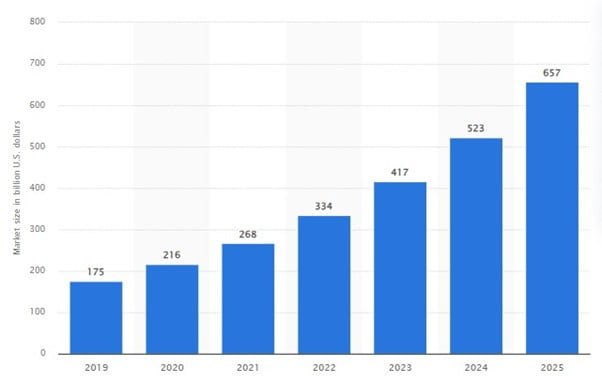There are a lot of benefits of launching a healthcare business as the population ages and concerns about health increase. There are a lot of different types of healthcare businesses that you can launch, such as eccomerce businesses that sell various supplements and other products that help improve our health.
The future of medicine eCommerce: from pills to pixels
Like in the case of other business spheres, the COVID-19 pandemic caused a massive shift in typical consumer behavior and accelerated technological innovations in healthcare. Once in-person services suddenly moved to the Internet and saw huge pandemic-induced growth.
Although the pandemic is finally gone, the global healthcare eCommerce market is still projected to grow from $309.62 billion in 2022 to $366.94 billion in 2023 at a compound annual growth rate (CAGR) of 18.5%. In the following years, it won’t show any signs of waning, reaching $732.3 billion in 2027 at a CAGR of 18.9%.
The post-pandemic world won’t ever be the same as many consumers are now accustomed to the convenience — and often lower costs — of remote medical services. Recognizing these opportunities, eCommerce giants and telehealth start-ups put down their stakes in the online pharmacy market.
Here is a short list of sources that can utilize a direct-to-patient approach and optimize the common user journey through medicine eCommerce:
- Online pharmacy websites
- Medical device and supply webshops
- Telemedicine platforms
- Health and wellness product marketplaces
- Health consulting portals
To compete successfully in this growing market, businesses must understand the challenges and opportunities inherent in an eCommerce model. They also need to understand the benefits of using healthcare marketing. That way they’ll be able to provide more cost-effective care and improve the health outcomes of their patients.

Statista: Projected global digital health market size from 2019 to 2025 (in billion U.S. dollars)
What lies ahead of medical eCommerce and how businesses can get prepared for the upcoming changes? What trends to harness and which can be overlooked? Below you’ll find valuable insights into these questions and will be able to draw your own picture of the industry and your development path in it.
Key trends shaping modern medicine eCommerce
Today there is no lack of trend-setters in the booming sphere of medical eCommerce. E-health start-ups and tech giants like Amazon that has been running secret healthcare projects are leveraging artificial intelligence, telemedicine developments, and remote monitoring devices.
These established and emerging trends open up significant market opportunities for companies in the e-healthcare sector. Below you’ll find the most prominent advancements that are likely to become the driving force behind your medical business.
The growth of omnichannel
Healthcare companies must strive to deliver a superior customer- and patient-experience across multiple touchpoints if they want to remain competitive in the current eCommerce environment. Under the omnichannel approach, the self-service workflow allows patients to easily interact with healthcare providers on their own terms while also saving such providers time, money, and effort by streamlining administrative tasks.
In an omnichannel setting, patients can book appointments through an online portal, virtually consult with a doctor or other healthcare provider on a mobile device, handle billing and insurance online, and even order prescriptions. There are also nice technical features that allow to preview a medical supply in 360 degree and check whether it meets the customer’s needs before online purchasing or trying it in a brick-and-mortar store.
Utilizing omnichannel strategies, healthcare organizations of all sizes can drive efficiencies that improve their results and lower patient care costs.
AI-powered personalization
Customer trust is the cornerstone of an effective online sales channel in the medical sector. Through the use of personalization, this can be significantly strengthened. In 2023, many businesses heavily rely on AI (and it’s not a bad thing) to make product recommendations for cross-selling and upselling.
Communication that is tailored and timed to effectively target customers also falls down into the category of personalization. For example, healthcare buyers are more sensitive to getting the right products at the right time, that’s why they need smart drug discovery and regular notifications about low stock levels. 24/7 consultation is achieved with the help of AI-driven customer support and chatbots.
The complexity of fluctuating prices in medical eCommerce also requires personalization. This guarantees B2B buyers have the most up-to-date pricing for their purchase orders and are always aware of their credit limits. In addition, AI can conduct predictive analysis for demand forecasting, ensuring product availability and optimizing warehouse spaces.
The rise of telemedicine & telepharmacy
According to the report Telemedicine Market – Growth, Trends, COVID-19 Impact, and Forecasts (2023-2028), the global market of telemedicine and virtual consultations amounted to $104.44 billion in 2021, but after the COVID-19 pandemic it is projected to rise to $272.76 billion by 2027.
Telehealth solutions have proved they are able to improve remote patient care and reduce companys’ costs through better management of chronic diseases, less travel times, and shorter hospital stays. Using mobile apps, patients can get an online psychiatric consultation or order the medicine prescribed by their doctor without leaving their home.
The need for better treatment results in technological innovations (like telehome) and more patients expecting convenient services. Thus, these services make medical care more accessible thanks to virtual doctor visits and remote patient monitoring tools.
Cybersecurity and data privacy
In recent years, healthcare records in many countries have been repeatedly compromised and it has turned out that almost a half of the internet-connected hospital devices and medical ecommerce websites are vulnerable to cyberattacks.
Since the healthcare sector stores large amounts of personal data and information, the ultimate goal is to protect sensitive patient data delivered online, considering the growing number and risks of data breaches.
To ensure safety beyond end-to-end encryption, modern cybersecurity measures include the interconnectivity of IoMT devices, threat detection in the network, and robust AI models. For example, it’s also possible to use blockchain technology in pharmaceutical supply chain management.
What features of medicine eCommerce platforms can help embrace these trends?
Today medical eCommerce aims to fill the gap between patients and their wellness needs. As industry-specific boundaries continue to blur and digital technologies reshape the healthcare system, it is as important as ever to find a feature-rich and flexible eCommerce platform.
In addition to obvious features like user-friendly and responsive web design, comprehensive product descriptions or mobile presence, eСommerce for online medicine shopping requires specific functionalities.
Here are the key features to seek in eCommerce platforms for the medical sphere:
1. Ability to personalize health profiles
Gone are the days of one-size-fits-all healthcare solutions, and modern medicine eCommerce focuses on personalization more than ever.
For example, personalized health profiles can keep track of a patient’s preferences, allergies, medical records, prescriptions, and test results, allowing more precise recommendations and an easier checkout process.
Technically, such high levels of personalization are the result of convenient data management, user-oriented design and smart algorithms. The starting point is data aggregation and integration. A comprehensive medicine eCommerce platform combines patient-provided information, electronic health records (EHRs), previous orders, and prescribed treatments into a centralized database.
Users should also have an option to manually input their medical history, current medications, and lifestyle choices, which can be done through intuitive forms and questionnaires. Of course, this information is not static and changes throughout one’s life. Thus, any changes in treatment plans or symptoms are subject to machine learning algorithms to identify patterns and bring better insights.
2. Automatic replenishment and reminder options
To effectively manage ongoing medications and wellness products, it’s recommended to look for platforms that offer auto-replenishment or automatic prescription refill options. This allows patients to reorder essential medical supplies in one click based on their prescription schedules.
Additionally, such features as medication reminders can help users adhere to prescribed regimens. To implement this functionality, the chosen eCommerce platform should have real-time data processing, analyze medication prescriptions within individual health profiles and send timely notifications.
This functionality is empowered by advanced data analytics engines, user-specific algorithms, inventory management, and notification triggers.
3. Telehealth and virtual medicine integration
In light of strong telehealth trends, modern digital platforms should offer real-time video consultations, diagnosis, and follow-up appointments. This requires a seamless architecture that connects users, healthcare providers, and the software.
The platform exposes APIs (Application Programming Interfaces) to exchange patient data, appointment scheduling, and secure video conferencing capabilities. A robust API gateway ensures data consistency, authentication, and authorization, safeguarding the privacy of sensitive health information.
Integrating telehealth services involves extending traditional user and health provider profiles to include virtual appointment preferences, video conferencing links, and secure access tokens. When a patient schedules a virtual consultation, the platform generates a unique video link associated with the provider and appointment.
WebRTC (Web Real-Time Communication) technology facilitates secure and high-quality video conferencing directly within the platform (without the need for external plugins). All these features prove that the chosen medical eCommerce platform should be ready for high load and traffic peaks.

Markets and Markets: The global digital pharmacy market forecasts
4. Secure payment methods and data protection
Given the sensitive nature of medical information and a large number of medical devices on the market, reliable security measures are non-negotiable. It’s better to opt for platforms that employ the latest encryption technologies, secure payment gateways, and strict data protection protocols to safeguard patients’ personal and health-related data.
To protect financial information, end-to-end encryption ensures the secure transmission of credit card details and personal information. Reliable payment gateways replace sensitive data with unique tokens, reducing the risk of data breaches.
Like other eCommerce platforms, medicine solutions implement firewalls, intrusion detection systems, and regular security audits, as well as access controls and role-based permissions. Compliance with global data protection regulations, such as GDPR (General Data Protection Regulation) and HIPAA (Health Insurance Portability and Accountability Act) ensures that patient health information remains secure and private.
5. Intelligent inventory & order tracking
For healthcare providers, it’s vital to get real-time updates on medication availability, stock levels and order fulfillment. These features minimize stockouts and increase patient satisfaction, which is crucial in the sphere of medical care.
Intelligent inventory and order tracking in medical eCommerce platforms are based on a centralized inventory management system. Real-time synchronization ensures that the inventory data is consistently updated as orders are placed, fulfilled, and shipped.
6. Patient reviews and rating system
To make informed decisions, users should be equipped with patient-generated feedback on medications, peer reviews and ratings, which ultimately fosters transparency and builds trust.
The evaluation system typically incorporates star ratings, often ranging from one to five stars, where users assign a rating based on their experience. In addition to star ratings, users can provide feedback on the effectiveness of medications, the quality of customer service, packaging, shipping speed, etc.
However, in the sphere of medicine, many platforms implement measures to verify that a review is submitted by a genuine customer who has made a purchase. This might involve validating the order ID or using other methods to ensure that fake or manipulated reviews are kept at bay.
As you can see, the future of medicine eCommerce is defined by platforms that prioritize user-centric design, security, and dynamic healthcare experiences. Investing into a scalable eCommerce platform with these essential features, the healthcare industry can elevate the standard of care and redefine the current approach to wellness.
Medical eCommerce website examples
It’s often said that а picture is worth a thousand words, and there’s a good reason for that. Discussing potential digital platforms for the medical sphere, their must-have features and downsides won’t give you a whole picture like a real-life case study.
Below you’ll find a few eCommerce websites for medicine that serve both B2C and B2B customers. Since digitalization is a major trend to watch in the medical sphere, you can check out some practical solutions and see their business outcomes.
It wasn’t the task to describe the experience of the best-known or biggest medicine websites as there isn’t enough information about their technical aspects. The main point was to look at such websites and their features from the inside, emphasizing their possible benefits.
Note: The websites below are powered by nopCommerce, a healthcare eCommerce platform that helps companies of any size redefine the path to healthiness, utilizing the latest Microsoft technologies. This open-source eCommerce platform works best for businesses that struggle with their current digital presence and need custom features they won’t get in popular hosted solutions.
The patient-centered focus of digital pharmacy
Online pharmacies are on the rise today, and they need to utilize the latest technologies to withstand growing traffic and store thousands of SKUs. Let alone that customer satisfaction and high retention rates require flexible order management and convenient prescription issuance.
Fracción is a virtual medical store, whose experience might be of use for medical vendors and eCommerce developers alike. One of its best features is the fractional sale of medicines so patients can buy the exact dose of pills or blisters indicated by the medical prescription, thus avoiding unnecessary spending on complete boxes.
How did Fracción achieve this convenience? Connecting with multiple systems, the website was extended with a number of custom plugins. These are responsible for validating which drugs and in what proportions are reimbursed by health insurance; applying government subsidies to orders; printing and uploading electronic prescriptions for controlled drugs, etc.
As a result, clients can subscribe to recurring medications for chronic diseases, and make regular purchases without the need to place an order each time. Offering this functionality, Fracción was a success during the pandemic and continues to grow by 289% if compared to its previous version.
Well-planned architecture for a good SEO effect
Since many medical websites had been created and launched many years ago, and got a complex structure that is hard to update, any subsequent (but necessary) changes become a real challenge. If they are not implemented, though, an eCommerce website even selling best-priced and high-quality products can lag behind its competitors.
In the case of Electron Microscopy Sciences (a manufacturer and distributor of microscopy, histology supplies, chemicals, and laboratory equipment), their website was designed 20 years ago and had a flat architecture, bad product categorization, poor content, and no mobile optimization.
The solution was to create a database-driven eCommerce website that has all the needed eCommerce features, support design flexibility and plugin architecture for any future updates. As the website analysis showed that customers were overwhelmed by the site’s intricate structure, a more convenient and user-friendly navigation system was implemented.
The changes made increased product discoverability and, consequently, customer satisfaction. The redesigned website is well optimized for desktop, mobile and tablet. Seven months after launch, it experienced improved positions for organic keywords by 15% on average.
The power of customization for an increase in orders
Due to their industry-related specifics, medical websites may require custom plugins and modules. Even the best eCommerce platforms can’t have them all pre-installed, so the most powerful solutions are flexible and scalable enough for developers to tailor them to any business needs.
For example, Acu-Market, one of the largest suppliers of acupuncture, herbal, homeopathic items in the United States, had an old website based on the legacy solution, where custom plugins overloaded the system instead of complementing it.
A custom Doctor Module was developed to simplify the sales process for doctors. Thanks to an easy-to-use interface, the doctor can select the patient from the list to whom a prescription will be sent. Then it’s possible to add a product and dosage instruction.
The prescription is sent to the patients via email and they can purchase it directly from the website using the link sent. All the information about prescriptions and orders is accessible through the dashboard, and can be used in targeted marketing campaigns to recover abandoned carts and increase sales.
A valuable feature of this medical website is the certification of doctors on their portal and internal verification to avoid imposters. This system doesn’t allow a non-verified specialist to issue prescriptions or send messages to patients, which protects sensitive data and ensures the high quality of medical services.
Is eCommerce the answer to the future of medicine?
Indeed, innovative and customer-centered healthcare solutions have given rise to a new era of accessibility, convenience, and personalized care. And medicine eCommerce goes beyond mere transactions, embracing virtual consultations, medication management, health education, and community engagement.
Beneficiaries of this new approach can be hospitals, laboratories, care facilities, pharmacies, dentistries, medical equipment stores, healthcare equipment manufacturers and suppliers, etc. Offering both patients and providers online options, combined with other helpful technologies such as real-time order tracking or auto replenishment, the future of medicine lies in striking a delicate balance between the convenience of technology and the human touch of medical expertise.






